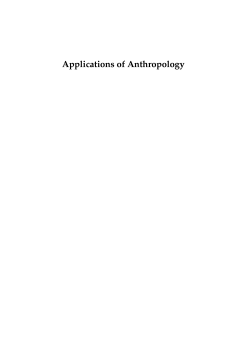
Additional Information
Book Details
Abstract
At the beginning of the twenty-first century the demand for anthropological approaches, understandings and methodologies outside academic departments is shifting and changing. Through a series of fascinating case studies of anthropologists’ experiences of working with very diverse organizations in the private and public sector this volume examines existing and historical debates about applied anthropology. It explores the relationship between the "pure and the impure" – academic and applied anthropology, the question of anthropological identities in new working environments, new methodologies appropriate to these contexts, the skills needed by anthropologists working in applied contexts where multidisciplinary work is often undertaken, issues of ethics and responsibility, and how anthropology is perceived from the ‘outside’. The volume signifies an encouraging future both for the application of anthropology outside academic departments and for the new generation of anthropologists who might be involved in these developments.
Sarah Pink has a PhD in Social Anthropology from the University of Kent and an MA in Visual Anthropology from the University of Manchester. Her first applied anthropology project was directly after graduating with a BA in Anthropology from the University of Kent, on a project about parcels service customers, followed by other consultancies. Since being awarded her PhD in 1996 (published as Women and Bullfighting in 1997) she has worked at the University of Derby and is Professor of Social Sciences at Loughborough University.
"The chapters in this book are all well executed and sprinkled through with references to classic anthropological theorists of the twentieth century…[It] establishes a very effective and thoughtful benchmark in a developing field of writing in anthropology, and deserves to become one of the central works in its field." —Andrew Strathern & Pamela J. Stewart in JRAI
Table of Contents
| Section Title | Page | Action | Price |
|---|---|---|---|
| Applications of Anthropology | i | ||
| CONTENTS | iv | ||
| LIST OF ILLUSTRATIONS | vii | ||
| ACKNOWLEDGEMENTS | viii | ||
| PART I. THE HISTORY AND DEVELOPMENT OF APPLIED ANTHROPOLOGY IN THE U.K. | viii | ||
| INTRODUCTION: Applications of Anthropology | 2 | ||
| Chapter 1. MACHETES INTO A JUNGLE? A History of Anthropology in Policy and Practice, 1981–2000 | 26 | ||
| Chapter 2. DINNER AT CLARIDGES?Anthropology and the ‘Captains of Industry’, 1947–1955 | 55 | ||
| PART II. ANTHROPOLOGY AND INDUSTRY | 71 | ||
| Chapter 3. THE PURE AND THE IMPURE?Reflections on Applying Anthropology and Doing Ethnography | 72 | ||
| Chapter 4. THE NEED TO ENGAGE WITH NON-ETHNOGRAPHIC RESEARCH METHODS: A Personal View | 91 | ||
| PART III. ANTHROPOLOGY AND THE PUBLIC SECTOR | 109 | ||
| Chapter 5. INTERNATIONAL DEVELOPMENT, SOCIALANALYSIS, … AND ANTHROPOLOGY?Applying Anthropology in and to Development | 111 | ||
| Chapter 6. ANTHROPOLOGY AT THE CENTRE: Reflections on Research, Policy Guidance and Decision Support. | 130 | ||
| Chapter 7.SPEAKING OF SILENCE: Reflections on the Application of Anthropology to the U.K. Health Services | 144 | ||
| PART IV. ANTHROPOLOGISTS IN THE PUBLIC DOMAIN: ANTHROPOLOGY MEDIA AND LAW | 168 | ||
| Chapter 8. ANTHROPOLOGISTS IN TELEVISION: A Disappearing World? | 171 | ||
| Chapter 9. RESEARCH, REPRESENTATIONS AND RESPONSIBILITIES: An Anthropologist in the Contested World of Foxhunting | 190 | ||
| Chapter 10. ‘CULTURE’ IN COURT: Albanian Migrants and the Anthropologistas Expert Witness | 209 | ||
| NOTES ON CONTRIBUTORS | 229 | ||
| INDEX | 233 |
